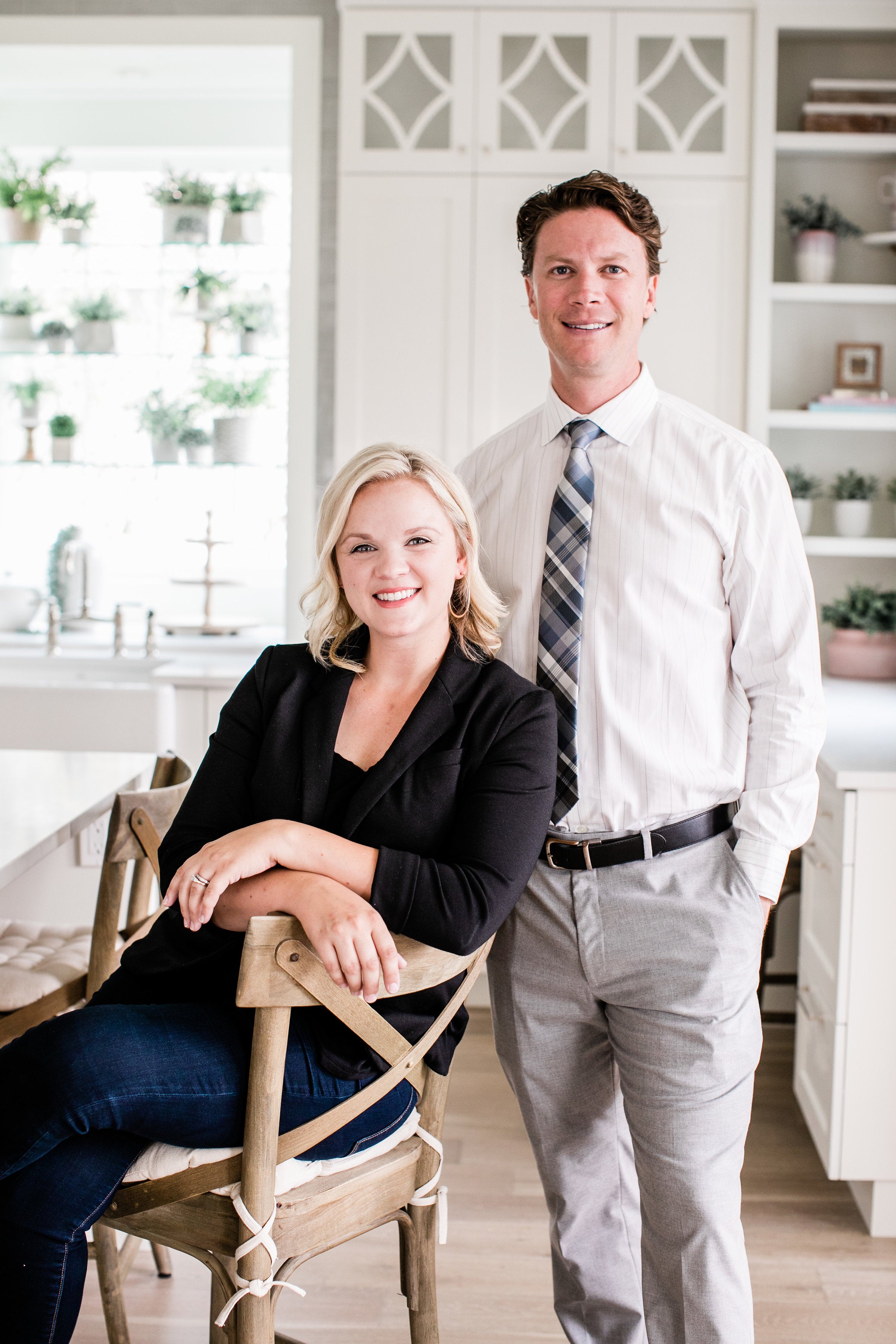The 50 States Project is a yearlong series of candid conversations with interior designers we admire, state by state. Today, we’re chatting with Boise, Idaho–based Emily Clark, who founded design-build firm Clark & Co. Homes with her husband, Dan Clark, in 2011. In addition to sharing favorite moments from recent projects, she talks about working in the design industry in one of the fastest-growing housing markets, how to own your online audience so you’re not subject to the whims of social media algorithms, and why she started selling her designs online as digital downloads.
You and your husband founded a firm together in 2011—how did you get started in design?
My husband, Dan, has been working in construction since 2005; he started working for a couple of custom builders and was really enjoying it. At the time, I was staying home with our first child. Neither of us studied construction or design in school. He’s a communications and marketing person and I was a music major—design was always my guilty pleasure. Even at 14, I was looking at every Better Homes & Gardens and [examining] whether they do a fixed floor plan and how do they change it, and how did that make the house feel?
The 2008 recession came at a time when we were still young and had young kids, and the builder Dan was working for was going under and couldn’t sustain having him. He went back to school for commercial real estate and we were able to come out of that and get our business started in 2011 in a good position since we didn’t have any debt that so many other design-build firms were struggling with at that time.
What kind of clients and projects were coming to you in the early days?
We’ve always been in residential single-family construction, We do family stuff, and then we really focused on a niche of people that don’t need as much space but still want the same level of high-end finishes in their homes—single-level planning, efficient floor plans and plenty of space to gather with family, but [not so many] extra spaces, guest spaces and things like that.
We started with a spec home, and that was so successful that we were able to gain some traction and market that. Most of what we do now is presold jobs, but we like to put out concept homes as well. That’s where we have 100 percent creative control over the project—it’s basically an elevated way of saying a spec home. We’re developing the plan and interiors and furnishings and everything, so we can put out our design aesthetic and attract the clients that jibe with that.
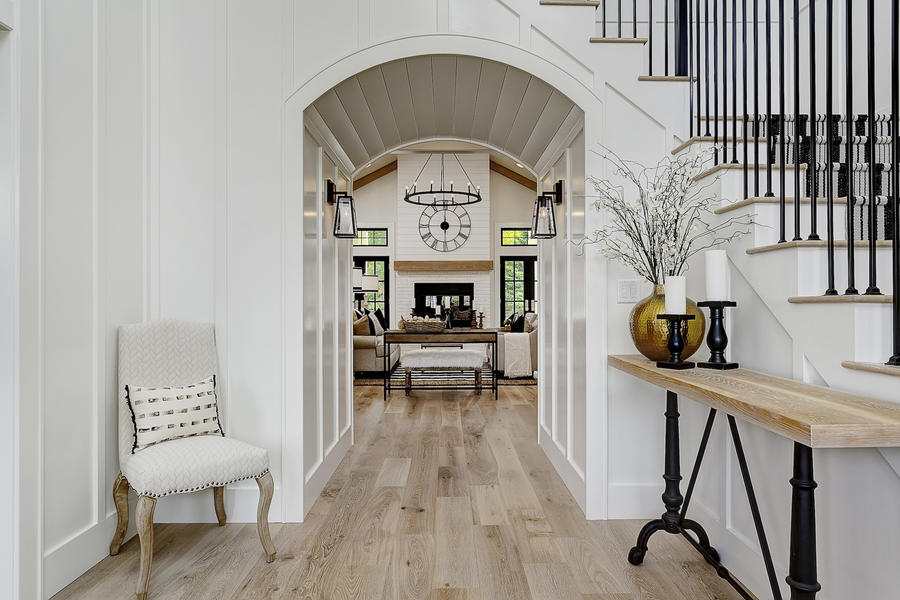
How often are you doing a concept home?
So, typically we do at least two a year. The goal is to move that up to four. With all of this upheaval in the current climate, it’s a bit scary to dive right in and build something start-to-finish without a client attached, so we’re also floating the idea of virtual concept homes. With what you can do with renderings and virtual tours right now, I think we’re uniquely poised to take advantage of that.
What software is essential for your firm?
Chief Architect, where you can easily transfer 2-D planning to 3-D. We’ll take what we have built there, and typically outsource that to somebody who’s going to transform that to a photorealistic rendering. We’re connected to a couple in the Philippines, and even some renderers in Syria, Russia and India, who are doing incredible work and are able to complete it quickly. That’s been the most beneficial to us, especially when our clients are like, “I’m not really sure about that bold tile choice. I’m hesitant to pull the trigger.” And then you can pull out that gorgeous rendering and be like, “Listen, this is the way it’s going to look,” and that’s usually enough to sell them on it right there.
What is the housing market like where you are and where you’re working?
Up until two weeks ago, Boise was consistently one of the top 10 fastest-growing cities in the nation. It’s been that way for the last couple years.
What does that look like and feel like on the ground?
It’s intense. You drive to any site visit and it’s like you can barely get down the road, so many people are building here at this time. But it’s been great because we’ve been able to dial into who we have decided to work with and find the people that value our process and aesthetics. It’s been wonderful, and we built a team to work with that’s been fantastic.
We have so much interest from clients outside of our state, especially California, Washington and Oregon. People are looking to Boise as a great place to raise a family. It’s a slower pace of life, has conservative values, is full of very friendly, outgoing, warm people—plus it’s a great use of your money. Even though land prices are increasing, due in part to all of the people coming from out of state, it’s still such [good] value when you consider what you can get here compared to places like California.
I suspect that once we’re able to get out of the social distancing period, things will pick up again fairly quickly. Everyone’s sort of paused right now—which is good, it’s a great time for us to dive back into some of the process things that we’ve been wanting to tighten up. In some ways, this period has been a bit of a blessing to have a minute to reflect and make sure the direction we’re going as a company is clear, and we’ve got a firm vision of what we’re wanting to do.

When you’re talking about job sites, are there literally new neighborhoods springing up everywhere?
Yes, you’re seeing whole farm fields being developed as fast as they can be, the lots are getting snapped up because the demand has been so pent-up with people wanting to come and not having the land catch up to the resurgence as fast as the construction companies did. A high demand is part of why the lot prices have gone up quite a bit in the last couple years, because [so many] people want to build. The unfortunate thing is that it is pricing some of our local clients out. We also have been dealing with a trade shortage for quite a while—that’s been a challenge to keep up with the demand. We have put together a solid team of trade contractors that we love working with, and we’ve been lucky that they’ve been very loyal.
Are you hired to do one project per neighborhood, or is it to do the whole development?
Usually the neighborhoods will open in phases, so say in the first phase, a lot of them will put together a builder team of four or five and give them the first option of lots. So we’ll take eight or nine of the lots, option those and start marketing them to our clients so we can be ready with the designs and the permit when the lots are ready to build on. I know people are still very interested in those five-acre lots where they can have that farm life vision, but those are getting harder to come by here.
How big are the projects?
We build as small as 1,800 square feet and up to 7,000 square feet. One of our main values is that no matter what size your home is, we design solutions to maximize your budget and get old-home character in your new construction. That’s pretty important to me. I grew up in New England, so a lot of what I was exposed to from an early age was historic homes and proportions and timeless properties and designs. So that’s really at the forefront of what I’m trying to do. I’m a millwork lover, so we’re always trying to get as much of that into a home as we can because of how much character it adds.
We find that whether you’re building a bigger or smaller home, the home still needs to function in a way that’s helpful to you and whatever stage your life is in. In a smaller home, it’s a lot easier to make a big impact with just a few design options, and sometimes it’s even more fun because you have to think outside the box in a small space in terms of how you can make the spaces multipurpose and beautiful at the same time.
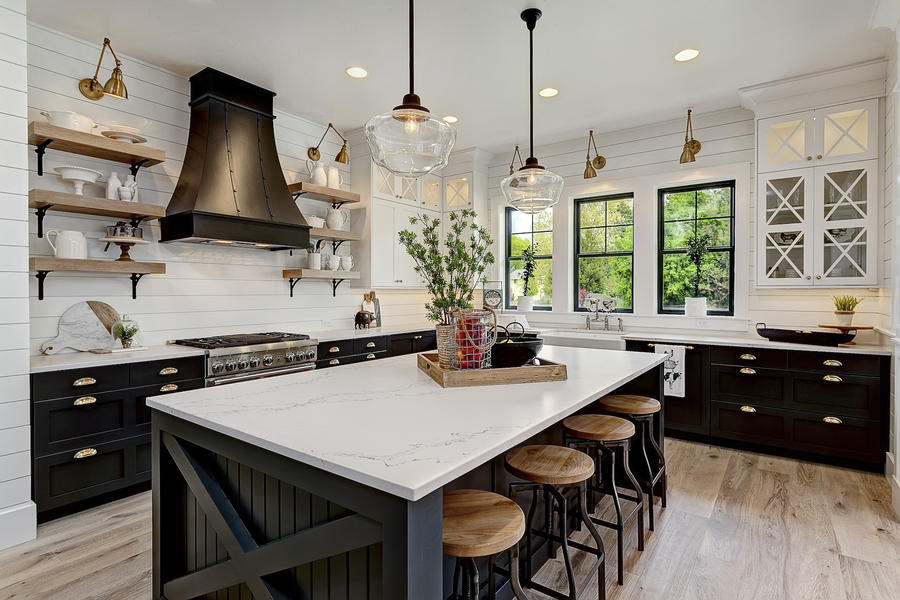
On the interior design side, where do you shop? What resources are available, and where do you go for the furnishings?
That’s been a bit of a challenge here in Boise. We don’t have many retail sources that fit my design aesthetic, so a lot of times we make buying trips down to the Salt Lake area; we spent a significant amount of time at the Las Vegas furniture market this year. Our goal is to make our whole process turnkey, so we would like to start providing the full furnishing package for a new home as well. We’re trying to dial in the vendors that we’re interested in working with, and eventually are hoping to open a bit of a showroom-slash-light-retail space ourselves.
I ran a boutique market of handmade goods for about 10 years before I got into home design, so I feel very connected to our local community and makers, and that’s an important thing I want to encourage. We’d love to be able to showcase those kinds of things in our designs—artists and craftspeople; at a time when you can buy so many things online, being able to sprinkle in a few one-of-a-kind items is what really sets people’s homes apart. Having said that, we do buy a lot of things online. That’s just the nature of the day right now.
Is there a prevailing regional or local aesthetic that a lot of people are following right now?
Farmhouse is still very much king here. Back in 2016, we built one of the first modern farmhouses in this area—the white house with the black windows. That house is everywhere now, but at the time was very new and fresh. Back then, the homes here were so heavily skewed toward Tuscan-looking interiors with stucco and wrought iron, that to see something white and bright with that bold, high-contrast trim color was very different for the area, and is still super popular. It’s the most popular, highly engaged with post anytime we use anything from that [kind of] project on our social channels—even now, years later.
However, I am definitely trying to move us along, because I’m ready for something different. I’m very excited about how much color we’re seeing come back to interiors, probably because I’ve been working in the black-and-white palette for so long, so I’m trying to push that as much as I can. The current model home we’re building is bringing in a ton of colors; it’s inspired by Southern coastal homes that you might find in the Charleston area, so blue cabinetry and corals and yellows and greens. I think people are ready for it.
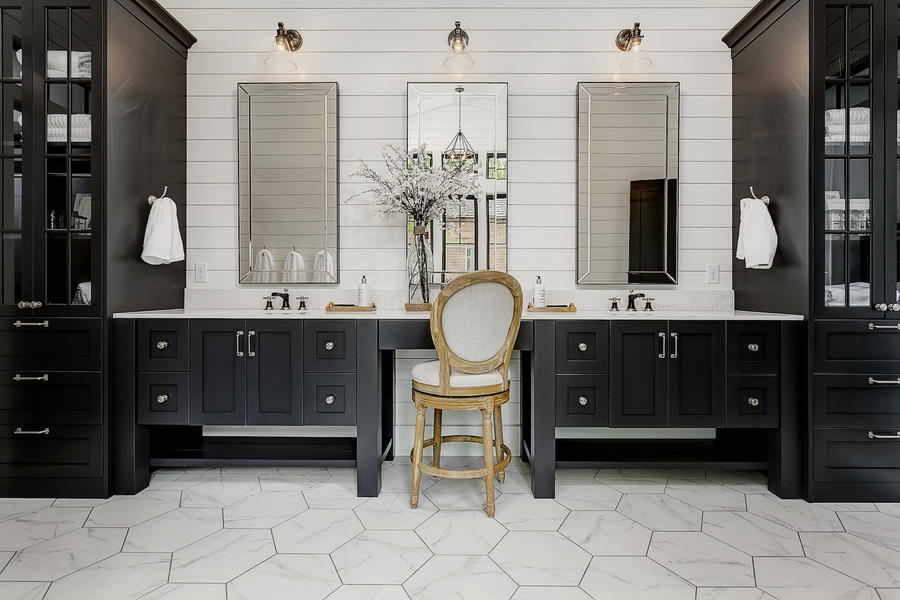
How many projects are you typically working on at a time as a firm?
We build about 12 homes per year. At the moment, we’ve probably got about seven going in various stages.
What does your team look like, and how have you built that team over time?
There are eight of us. Dan manages the construction arm of the company and the finances, and I manage the creative side, overseeing social media and the website and branding, as well as the interior design processes. Then we’ve got a gentleman that does all of the drawing, since things have gotten pretty busy for my husband.
I’ve got a lead designer that does a majority of the clients’ design so I can focus on the model homes, the concept stuff and branding. We’ve got a marketing manager that is our first contact point between interested clients and us—she’s actually a former client of ours, and she’s originally from California, so she speaks Californian and can tell clients what they need to know about integrating into the Idaho population.
Then we’ve got a project manager in the office, a project manager in the field, and a media integrator, who works closely with me to translate what our brand looks like in the virtual world, including social media and formatting our downloads.
How did you come to start offering your designs for purchase online?
Right now, we have general layouts on offer. We’ve had a lot of people calling from all over the country, like, “I wish you built here. I really love this plan.” And of course we want to be able to build for everybody, but that’s not possible, so being able to give them a jump start in their planning process via layouts and exterior elevations, and then they can take those to their local architect or draftsperson and get those drawn up in a construction set appropriate for their local statutes and codes.
We also offer our design specifications. So in a project like the Heartland Farmhouse from 2016, you can get every finish we used in that house, the paint, plumbing, cabinet knobs, lighting, surfaces, all of that in a PDF so you can replicate. Not everything is going to stay up-to-date four years later, but the mood boards are there, and the direction and vision of the project.

What first led you to put those design downloads online—and what was the response?
Daily on Instagram, I was being asked about sources—they would even call the office to ask—and it was taking a lot of my marketing team’s time to answer questions. We felt like: Let’s put everything together in one place and offer this at a fair price so that people can get answers but also so that we can monetize those answers and be paid for the work we’ve done. That’s one way a custom-build firm can scale what they’re doing, is to put that package together. There’s no reason why you couldn’t build some of these concept homes multiple times over and still have them feel very unique in whatever part of the country that they’re in.
We don’t put those together for our custom clients. We’re only selling downloads from the creative control concept homes; we want to respect our clients, so we keep those sources private to them. So far, it’s been a very good response. Just yesterday, we were making dinner and we got a PayPal invoice and there’s money in your account and it’s just like I did nothing. Somebody found us.
Until this year, we didn’t even advertise them very heavily. We posted pictures of the project we started with on Pinterest, but didn’t really even push it much, and still people have found us and embraced that. So we’re making a big push to our Pinterest marketing now and planning to put together rich pins to direct people to our website.
Are those design documents a significant revenue generator?
They have been. They add up. Even if you’re only selling a layout for $25, that turns into $40,000 pretty quickly. We are just thrilled. I think that we could dig even deeper into what we could offer people. I think sometimes people don’t need the whole-home specifications, maybe they just want one room, so we’re thinking of going a little bit smaller. Lower-price-point items are faster to sell, so it’s just trying to find that sweet spot of what price to ask for your work.
We’re excited this year to start our blogs on our website and newsletter, so we’re putting together some free downloads to capture email lists. We love our Instagram and Facebook audiences, but you never know what’s going to happen with algorithms. So being able to own our audience has become a priority for us as well.
When did you first post those farmhouse downloads online?
We built it in spring 2016, and posted the downloads in fall 2016. First we offered the kitchen package—we were dipping our toe into it because at the time, people were still keeping their floor plans on their websites. People still do, actually—lots of builders just have them up on the web. But we really felt like we were starting to see a lot of our designs pulled off the internet and copied, and it was disheartening, so we made the decision to pull most of our floor plans from the site but to keep all of the interior pictures there so people could see what they’re getting if they’re willing to pay for it.
We haven’t felt the need to dive into selling full sets of plans, because there are a lot of legalities involved in that. But we would like to be able to say, “Hey, you like this plan, but maybe you want to move a wall or add a space here,” and at some point if that turns into being able to offer people a full set of plans, we’re open to that as well.
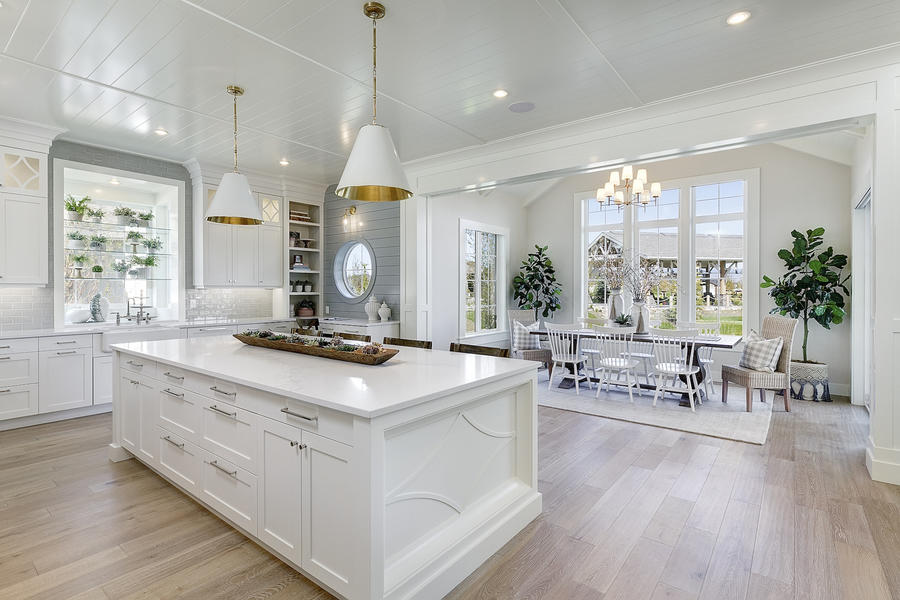
Where do you see the most opportunity to grow?
The hardest part of my job is figuring out one thing to focus on at a time. So I’m very optimistic. Despite what’s going on right now, I’m excited about how people in our industry are putting themselves out there, making a lot more available, the sharing and networking going on among designers. That did not exist when I was first starting to design; you felt like you were all by yourself in Idaho in your head all the time, trying to figure out, Does anybody even like this?
It’s so invigorating to get with these groups of powerhouse design minds who are just willing and generous in sharing, and I feel like our industry is rising as a whole. I think it’s easier than ever to prove your value in this area. We went through a period as a nation where everybody was intensely into DIY, and then we’ve all discovered that we’re not so great at DIY and we wanted a higher-end finish, so now I think people are like, Yes, I appreciate how hard your job is.
What are some of the biggest challenges you’re looking at internally?
We’re at this place in our company where it’s like: Do we grow in terms of jobs and employees, or focus on what we’re really good at and scale the virtual and digital design? I think those are two different things. I’m back and forth—there’s been such a high demand here; it’s been hard to take a minute to step back and say, “Do we really want to take all these jobs just because they’re coming?” Because that’s money and it’s tempting, for sure. Or, do we want to focus on our point of view and push our design agenda and vision for our company?
Do you come to that answer by crunching numbers, or is that more of an emotional decision?
That’s where Dan and I are unique and balance each other. He’s the money person and I’m the creative, so we are having daily conversations about the ideal, and balancing that with what it’s going to cost. He has a real respect for the design; especially coming from a communications and marketing background, he knows how important it may be to spend more on a concept home than our local market may support, because it pays dividends in other ways. We have a bit of a dance on a daily basis.
What are the challenges of working with a spouse? Did you ever expect to work together?
Being able to work together has, for the most part, been awesome. For one thing, both of us are 100 percent committed to the success of this company. It gives us this unique focus to be able to move forward together. We both love learning about how people build around the country, so everywhere we travel we’re always looking at homes together. It’s actually hard for us to turn off the business talk when it’s Friday date night and we’re like, “Let’s not talk about the business anymore.” We’ve got to have other things. Luckily, we’ve got five kids too, so they definitely keep us grounded and make us put the phone down and close that laptop and look outside and see the world as well.
To learn more about Emily and Dan Clark, visit the Clark & Co. Homes website or find them on Instagram.
















